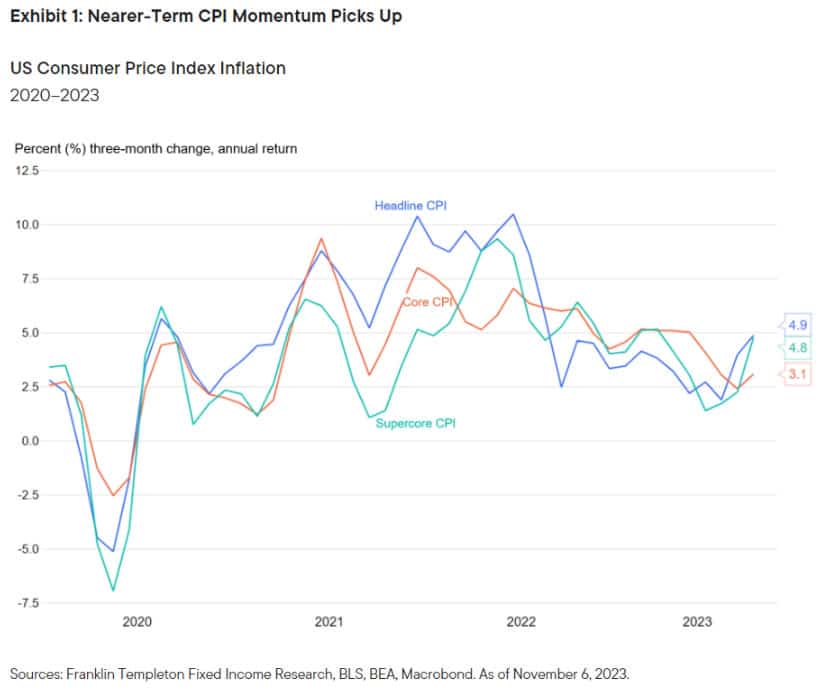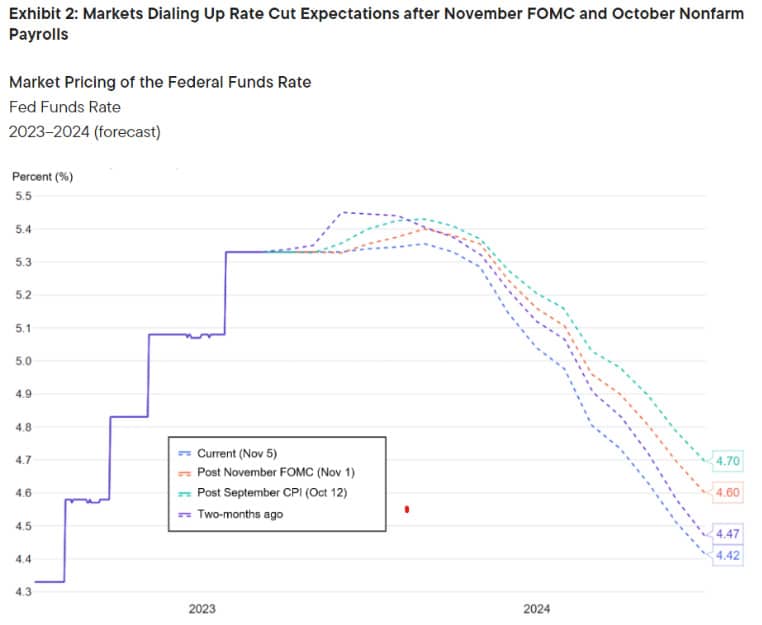
Inflation is not quite under control yet, and too volatile for comfort, especially with the risk of another energy shock always just around the corner: Franklin Templeton’s Sonal Desai
A dovish nudge in the Federal Reserve’s (Fed’s) November press conference pushed markets to again price a significant monetary easing as early as mid-2024.
Franklin Templeton Fixed Income CIO Sonal Desai sees this market reaction as an excess of exuberance that sets the stage for more volatility. She shares her latest insights on the policy outlook and the implications for investors.
Desai says, “For the best part of this tightening cycle, the Federal Reserve (Fed) has been playing a tug of war with financial markets, with the central bank trying to persuade investors that a period of higher interest rates is needed to bring inflation durably under control, and investors resisting or even “fighting” the Fed.
“Over the past three months, the Fed seemed to have gradually prevailed, and bond yields rose to nearly 5%. The Fed, however, might have overestimated the extent to which financial markets had really come around to its view. At the November Federal Open Market Committee (FOMC) meeting, Fed Chairman Jerome Powell gave a gentle dovish nudge, not just with the expected decision to hold rates, but also in suggesting that growth might already be running under its (temporarily elevated) potential pace, and de-emphasizing the importance of the Fed “dots” (which point to one more hike). A handful of weaker-than-expected economic data compounded the impact on market prices.
“So as Powell noted that the Fed’s inflation fight was getting important help from tighter financial conditions, investors promptly drove financial conditions in the opposite direction, with lower bond yields and higher stock prices.
“Powell said the Fed still needs to answer the question of whether monetary conditions are tight enough, and only after it has found the answer will it move to pondering for how long conditions should remain tight. However, investors quickly provided their own answers: Monetary policy is plenty tight already, and by the middle of next year it should start loosening at a brisk pace, to cut the fed funds rate to close to 4% by end-2024.1
Also read: Identifying Rising Stars Amid a Darkening Fundamental Outlook
“Satisfied with the progress achieved, Powell gave investors just a gentle nudge of encouragement, and they ran with it in a burst of what I see as an excess of exuberance.”
The Fed is still grappling with three difficult questions:
- How persistent is inflation?
- How fast is the economy likely to lose steam?
- Where does the neutral policy rate sit?
She says “Compared to a year ago, inflation is now quite close to target—and yet still too far away. There are a variety of inflation measures that analysts throw around: consumer price index (CPI), personal consumption expenditures (PCE), headline, core, 12-month change, monthly change annualized. Some look very reassuring, others much less so.
“My preference is to look at core CPI and take the month-on-month change, which gives us the current pace of price growth unaffected by older base effects. That rate, annualized, is still bouncing around a lot. In July it was just 1.9%; in September it was 3.9%. The three-month average is still above 3%; the six-month average is close to 4%.2 Other measures like headline CPI and supercore CPI – which strips out not just food and energy but also housing, and has been often highlighted by Powell – run even higher, with a three-month average close to 5%, as the chart below shows.
“Inflation is not quite under control yet, and too volatile for comfort, especially with the risk of another energy shock always just around the corner. Plus, a number of structural factors, from demographics to the green transition, suggest that long-term inflation pressures will be more robust.
“The US economy has proved extremely resilient, expanding at a nearly 5% annualized pace in the third quarter. As I have argued, this should not be too surprising; households had a healthy cushion of excess savings and fiscal policy remains very loose. Nonetheless, funding costs for households and corporates have risen across the board, and despite healthy balance sheets, monetary tightening is beginning to bite. The latest data are consistent with some deceleration in economic growth and job creation. Monetary policy just might be tight enough to cool the economy to the right sub-potential pace. Maybe.
“As far as the neutral policy rate is concerned, I believe the Fed is too dovish; it still seems to think that once things have settled, short-term rates can again be quite low, though not as low as in the post-global-financial-crisis (GFC) period. My own view remains that the neutral policy rate will prove to be closer to 4% or higher rather than the 2.5% still envisaged by the Fed.
“With all this, regarding the forthcoming monetary policy decisions, the Fed likely feels it is now in fine-tuning territory, justifying a prudent approach—watch the data, and decide meeting by meeting what to do next.
“I would not rule out the need for another rate hike yet—inflation pressures remain resilient with plenty of scope for unwelcome surprises. And I strongly believe that policy rates will have to remain at-or close to current levels for the better part of 2024 in order to secure the sustained decline in inflation to the 2% target that the Fed is pursuing.
Sources: Franklin Templeton Fixed Income Research, Federal Reserve Bank of New York, CME Group, Macrobond as of November 6, 2023. There is no assurance that any estimate, forecast or projection will be realized.
“However, Powell’s dovish nudge at the November press conference has sufficed to push markets in a completely different direction: They have not only priced out any further rate hikes, but now expect about a full percentage point of rate cuts next year, starting already before mid-year, which seems unreasonably aggressive, in my view. This in turn will now complicate the Fed’s job and in my view, set the stage for more volatility and a likely rebound in yields over the coming months.”
Endnotes
- There is no assurance that any estimate, forecast or projection will be realized.
- Source: Bureau of Labor Statistics and Franklin Templeton Fixed Income. As of November 6, 2023



































